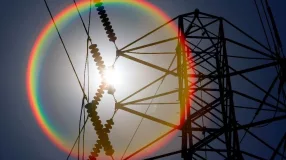The Rocky Mountain Institute (RMI), a Colorado think-tank with ties to 2020 presidential candidate Tom Steyer, recently released two reports (one on pipelines and one on power plants) attempting to convince regulators, investors and other stakeholders that continued investment in new natural gas infrastructure has “existential risks.” RMI’s assessment lacks rigor and fails to disclose key information, which we outline below. It’s also contradicted by recent analysis demonstrating that natural gas will remain at the forefront of meeting our domestic energy needs and that related infrastructure will be crucial to meeting current and future U.S. energy demand.
Natural gas now accounts for roughly 35 percent of the daily U.S. power generation fuel mix – up from about 23 percent in 2009 – and demand is forecasted to grow through 2040. RMI acknowledges this in its report, “Prospects for Gas Pipelines in the Era of Clean Energy,” (pipeline report) explaining that increased natural gas production has “fundamentally reshaped the US electricity sector over the past two decades.” As this report describes, the use of natural gas for power generation has grown more than 160 percent. The RMI pipeline report acknowledges the important and growing role of natural gas in the U.S. power sector:
At the same time, natural gas transmission pipeline capacity to bring gas to power plants and customers in other sectors has increased by over 60 percent since 1997, as pipeline developers have invested over $115 billion in new intra- and interstate projects.
It further recognizes that this growth is forecasted to continue for the foreseeable future:
This trend of coupled and growing investment in gas power plants and gas pipelines is set to continue. There are at least $90 billion worth of new gas-fired power plants planned for construction in the coming 10–15 years, along with over $30 billion of investment associated with gas transmission projects.
Having set the stage, RMI makes a complete 180 from the widely accepted conclusion that natural gas will remain central to the U.S. energy economy. The RMI pipeline report and the companion “The Growing Market for Clean Energy Portfolios” (power plant report) cherry-pick data and assumptions to support their central conclusion about the future role of natural gas and gas infrastructure. This is illustrated by the examples below.
RMI Claim: “[Clean Energy Portfolios] are lower cost than 90 percent of proposed gas-fired power plant capacity.”
Reality: The methodology that RMI uses to reach this conclusion is questionable at best. For instance, RMI relies on the U.S. Energy Information Administration’s 2019 Annual Energy Outlook (AEO 2019) to estimate its price scenarios throughout both reports. The problem with this is that the gas price projections for 2019 in the previous two AEOs (2017 and 2018) overestimated actual 2019 Henry Hub gas prices by 35 and 60 percent. Relying on the AEO, which has typically overestimated future natural gas prices, is one of the factors that leads to RMI incorrectly determining that clean energy portfolios are more economic than new gas-fired generation.
The AEO 2019 uses natural gas price estimates that are roughly $0.40/MMBtu higher than the Henry Hub Natural Gas Futures, which is more reflective of actual prices and price expectations over the next decade. This 15 percent overestimate would roughly translate to a $2.50 per megawatt hour (MWh) cost difference for a new combined cycle natural gas-fired power plant. RMI analyzed 88 new facilities representing 68 gigawatts of anticipated new capacity. Utilizing Henry Hub futures prices translates to nearly $2 million per plant annual savings in dispatch cost relative to what RMI assumed. This price difference is very material to the veracity of RMI’s assertion that the clean energy portfolios (a combination of renewables, storage and efficiency) can outcompete 90 percent of proposed gas-fired capacity. It is just one instance of where RMI cherry-picked assumptions to get its desired answer.
Interestingly, while RMI relies on the AEO 2019’s forecasted price estimates, it doesn’t use the same report’s forecast for natural gas demand or increased natural gas power generation capacity.
The AEO 2019 finds that both “new high-efficiency natural gas-fired combined-cycle and renewables generating capacity is added steadily through 2050 to meet growing electricity demand,” resulting in an additional 179 GW of new natural gas-fired capacity being added by 2040.
RMI Claim: “While direct emissions from natural gas are less carbon-intensive than the coal it has replaced, increased gas generation is contributing significantly to rising power sector CO2 emissions.”
Reality: RMI uses the Rhodium Group’s estimate of 2018 emissions to reach the conclusion that natural gas is “contributing significantly” to increased power sector emissions; but that’s not what the Rhodium Group actually concluded.
For a bit of perspective, Rhodium Group estimated that energy-related CO2 emissions increased by 2.7 percent and economy wide emissions by 1.5 to 2.5 percent in 2018. Notably, the group said it doesn’t “expect a repeat of 2018 this coming year.”
Emissions grew across all evaluated sectors: transportation, industry, buildings and power. But even with the year-over-year emissions increase, Rhodium Group finds that total U.S. greenhouse gas emissions are still 10.7 to 11.6 percent below 2005 levels.
Rhodium Group credits colder weather as being partially responsible for the slight uptick in power sector GHG emissions, as well as lower than expected wind and solar generation. It explains that “U.S. power consumption increased meaningfully in 2018.” Not once, however, does Rhodium Group say natural gas is responsible for “contributing significantly” to increased emissions.
To the contrary, multiple agencies and organizations have credited increased natural gas use with helping the United States reduce its emissions. Most recently, an Environmental Defense Fund report found:
[N]atural gas substituting for coal and petroleum coupled with large increases in renewable energy generation —primarily wind — were responsible for 60% and 30%, respectively, of the decline in CO2 emissions from the U.S. power sector between 2005 and 2015.
EIA similarly found 50 percent more CO2 emissions reductions attributable to natural gas than were attributable to wind and solar combined since 2005.
RMI Claim: “[T]he role of gas as a “bridge fuel” is behind us.”
Reality: The INGAA Foundation in May published a study by Black & Veatch (B&V), concluding that in both “balanced transition” and “rapid renewables transition” scenarios, natural gas will play an important role in the U.S.’s progress toward a lower-carbon economy. Renewables account for roughly 20 percent of total U.S. power generation by 2040 in the balanced scenario and 50 percent in the more aggressive implementation of renewable portfolio standards (RPS) scenario.
Principal study author Deepa Poduval of B&V, explained:
The attributes of natural gas and our robust natural gas infrastructure mean that natural gas will remain an essential source of energy within a greener U.S. energy mix.
The report found that rising demand and increased production “could spur the need for up to 21 billion cubic feet per day (Bcf/d) of new gas pipeline infrastructure,” including 11 Bcf/d just for power generation. As Poduval explained in reference to the ‘balanced scenario’:
So, this is a balanced world where natural gas plays a part, but not a dominant part, in replacing the coal and nuclear retirements. But we see that even at that level, gas demand to serve power generation is about 11 Bcf/d, and quite robust.
Even in the 50 percent RPS scenario, B&V found that natural gas demand would remain relatively close to what it is today.
Despite RMI’s assertions that natural gas infrastructure investments will result in “stranded assets,” the technical analysis and economics clearly show that natural gas will remain central to our energy economy even as renewables account for a greater share of the U.S. power generation portfolio. Natural gas will play a significant role, offering a clean-burning, affordable and reliable option to provide a foundation for this renewable growth.







